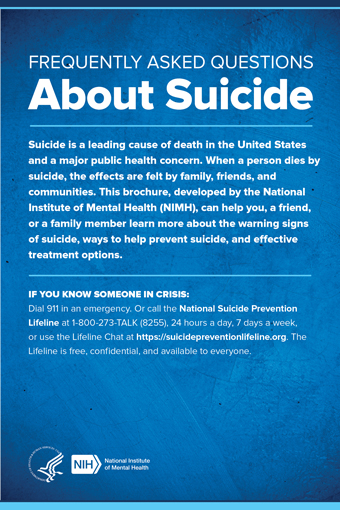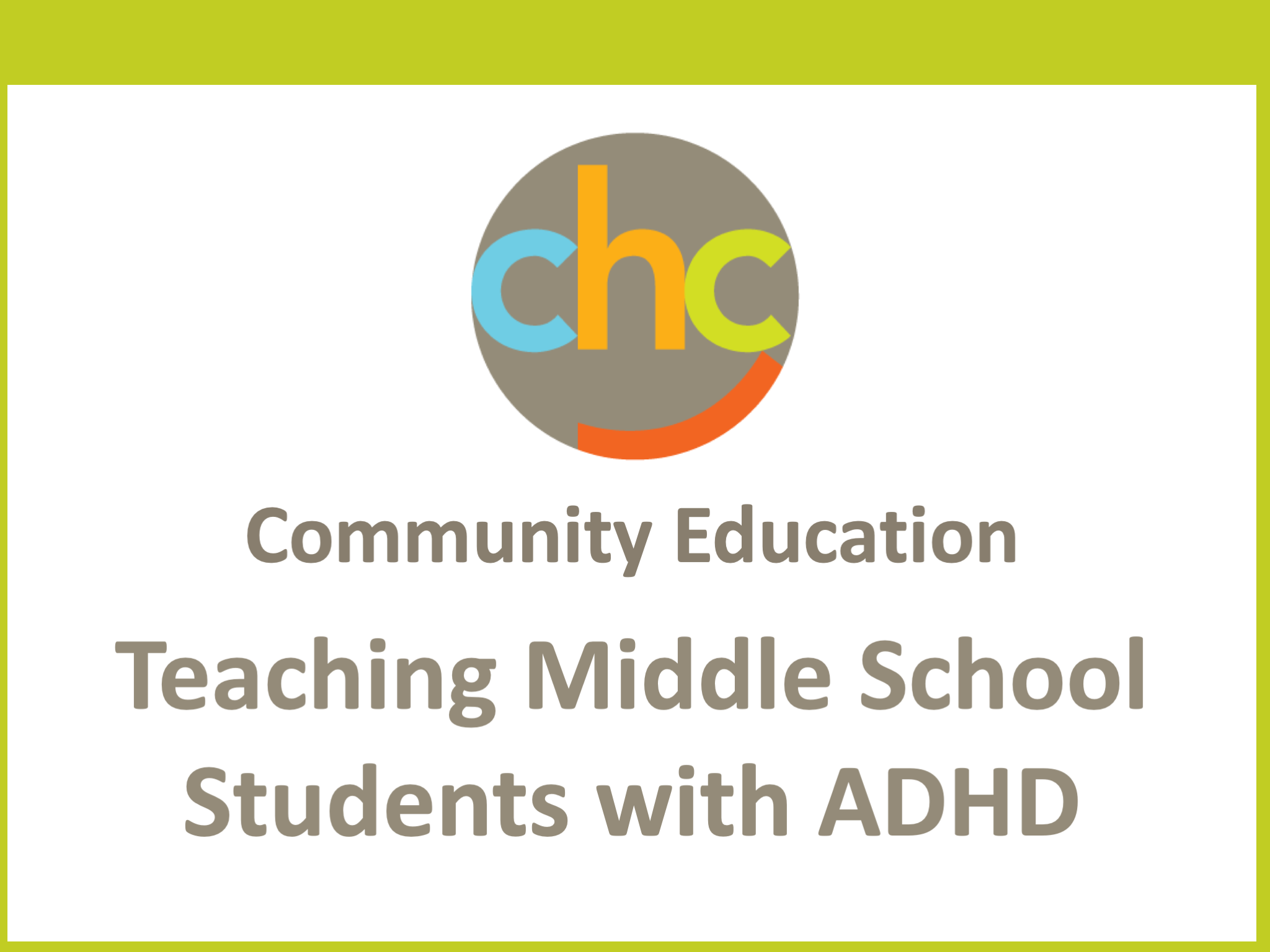
Suicide is a leading cause of death in the United States and a major public health concern. When a person dies by suicide, the effects are felt by family, friends, and communities. This brochure, developed by the National Institute of Mental Health (NIMH), can help you, a friend, or a family member learn more about the warning signs of suicide, ways to help prevent suicide, and effective treatment options.
What is suicide?
Suicide is when people harm themselves with the goal of ending their life, and they die as a result.
A suicide attempt is when people harm themselves with the goal of ending their life, but they do not die.
Avoid using terms such as “committing suicide,” “successful suicide,” or “failed suicide” when referring to suicide and suicide attempts, as these terms often carry negative meanings.
Who is at risk for suicide?
People of all genders, ages, and ethnicities can be at risk for suicide.
The main risk factors for suicide are:
- A history of suicide attempts
- Depression, other mental disorders, or substance use disorder
- Chronic pain
- Family history of a mental disorder or substance use
- Family history of suicide
- Exposure to family violence, including physical or sexual abuse
- Presence of guns or other firearms in the home
- Having recently been released from prison or jail
- Exposure, either directly or indirectly, to others’ suicidal behavior, such as that of family members, peers, or celebrities
Most people who have risk factors for suicide will not attempt suicide, and it is difficult to tell who will act on suicidal thoughts. Although risk factors for suicide are important to keep in mind, someone who is showing warning signs of suicide may be at higher risk for danger and need immediate attention.
Stressful life events (such as the loss of a loved one, legal troubles, or financial difficulties) and interpersonal stressors (such as shame, harassment, bullying, discrimination, or relationship troubles) may contribute to suicide risk, especially when they occur along with suicide risk factors.

What are the warning signs of suicide?
Warning signs that someone may be at immediate risk for attempting suicide include:
- Talking about wanting to die or wanting to kill themselves
- Talking about feeling empty or hopeless or having no reason to live
- Talking about feeling trapped or feeling that there are no solutions
- Feeling unbearable emotional or physical pain
- Talking about being a burden to others
- Withdrawing from family and friends
- Giving away important possessions
- Saying goodbye to friends and family
- Putting affairs in order, such as making a will
- Taking great risks that could lead to death, such as driving extremely fast
- Talking or thinking about death often
Other serious warning signs that someone may be at risk for attempting suicide include:
- Displaying extreme mood swings, suddenly changing from very sad to very calm or happy
- Making a plan or looking for ways to kill themselves, such as searching for lethal methods online, stockpiling pills, or buying a gun
- Talking about feeling great guilt or shame
- Using alcohol or drugs more often
- Acting anxious or agitated
- Changing eating or sleeping habits
- Showing rage or talking about seeking revenge
Family and friends are often the first to recognize the warning signs of suicide, and they can take the first step toward helping a loved one find mental health treatment.
What treatment options and therapies are available?
Effective, evidence-based interventions are available to help people who are at risk for suicide:
- Cognitive Behavioral Therapy (CBT): CBT is a type of psychotherapy that can help people learn new ways of dealing with stressful experiences. CBT helps people learn to recognize their thought patterns and consider alternative actions when thoughts of suicide arise.
- Dialectical Behavior Therapy (DBT): DBT is a type of psychotherapy that has been shown to reduce suicidal behavior in adolescents. DBT also has been shown to reduce the rate of suicide attempts in adults with borderline personality disorder, a mental illness characterized by an ongoing pattern of varying moods, self-image, and behavior that often results in impulsive actions and problems in relationships. A therapist trained in DBT can help a person recognize when their feelings or actions are disruptive or unhealthy and teach the person skills that can help them cope more effectively with upsetting situations.
- Brief Intervention Strategies: Research has shown that creating a safety plan or crisis response plan—with specific instructions for what to do and how to get help when having thoughts about suicide—can help reduce a person’s risk of acting on suicidal thoughts. Staying connected and following up with people who are at risk for suicide also has been shown to help lower the risk of future suicide attempts. Research also has shown that increasing safe storage of lethal means can help reduce suicide attempts and deaths by suicide. In addition, collaborative assessment and management of suicidality can help to reduce suicidal thoughts.
- Collaborative Care: Collaborative care is a team-based approach to mental health care. A behavioral health care manager will work with the person, their primary health care provider, and mental health specialists to develop a treatment plan. Collaborative care has been shown to be an effective way to treat depression and reduce suicidal thoughts.
What should I do if I am in crisis or someone I know is considering suicide?
If you notice warning signs of suicide—especially a change in behavior or new, concerning behavior—get help as soon as possible.
Family and friends are often the first to recognize the warning signs of suicide, and they can take the first step toward helping a loved one find mental health treatment.
If someone tells you that they are going to kill themselves, do not leave them alone. Do not promise that you will keep their suicidal thoughts a secret—tell a trusted friend, family member, or other trusted adult.
Call 911 if there is immediate danger, or go to the nearest emergency room.
In a crisis, you also can contact:
- 988 Suicide & Crisis Lifeline number (call or text 988)
- Crisis Text Line
Text “HELLO” to 741741
The Crisis Text Line is available 24 hours a day, 7 days a week. This confidential service helps anyone, in any type of crisis, connecting them with a crisis counselor who can provide support and information.

What if I see suicidal messages on social media?
Knowing how to get help when someone posts suicidal messages can help save a life. Many social media sites have a process to get help for the person posting the message.
If you see messages or live streaming content that suggests someone is actively engaging in suicidal behavior, call 911 or call the National Suicide Prevention Lifeline at 1‑800‑273‑TALK (8255).
Does asking someone about suicide put the idea in their head?
No. Studies have shown that asking people about suicidal thoughts and behaviors does not cause or increase such thoughts. Asking someone directly, “Are you thinking of killing yourself?” can be the best way to identify someone at risk for suicide.
Do people “threaten” suicide to get attention?
Suicidal thoughts or actions are a sign of extreme distress and an indicator that someone needs help. Talking about wanting to die by suicide is not a typical response to stress. All talk of suicide should be taken seriously and requires immediate attention.
How do suicide rates differ among groups of people?
Data show that the rates of suicide attempts and suicide deaths vary according to characteristics such as age, gender, race, ethnicity, and geographic location. The most recent statistics on suicide and more information about suicide risk are available on the Centers for Disease Control and Prevention’s suicide prevention webpage and the National Institute of Mental Health’s suicide statistics webpage.
How can I find help?
If you have concerns about your mental health, tell your health care provider. Your health care provider will listen to your concerns and can help you figure out next steps. Find tips for talking with your doctor about mental health concerns.
To find mental health treatment services in your area, call the Substance Abuse and Mental Health Services Administration (SAMHSA) National Helpline at 1-800-662-HELP (4357), visit the SAMHSA online treatment locator , or text your ZIP code to 435748.

Dialectical Behavior Therapy (DBT) has been found effective for a range of mental health conditions and issues, including depression and self-harm and suicidal ideation. Check out this article to learn more about DBT and RISE, CHC’s intensive outpatient program.
Where can I learn about NIMH research on suicide?
NIMH supports promising research that is likely to have an impact on reducing suicide in the United States. Research is helping improve our ability to identify people at risk for suicide and to develop and improve effective treatments. NIMH researchers continue to study suicide and how to best implement suicide prevention and intervention programs in different settings, including health care, community, school, and the justice system.
Learn more about NIMH research priorities and recent research on suicide prevention.
For additional information about suicide prevention efforts, visit the National Action Alliance for Suicide Prevention and Zero Suicide.
What should I know about clinical trials?
Clinical trials are research studies that look at new ways to prevent, detect, or treat diseases and conditions. Although individuals may benefit from being part of a clinical trial, participants should be aware that the primary purpose of a clinical trial is to gain new scientific knowledge so that others may be better helped in the future.
Talk to your health care provider about clinical trials, their benefits and risks, and whether one is right for you. Learn more about participating in clinical trials.
Download a PDF of the Frequently Asked Questions About Suicide publication.
Source: National Institute of Mental Health | Frequently Asked Questions About Suicide, https://www.nimh.nih.gov/sites/default/files/documents/health/publications/suicide-faq/suicide-faq_0.pdf | Public domain. Revised in 2023. Last reviewed October 2024.





